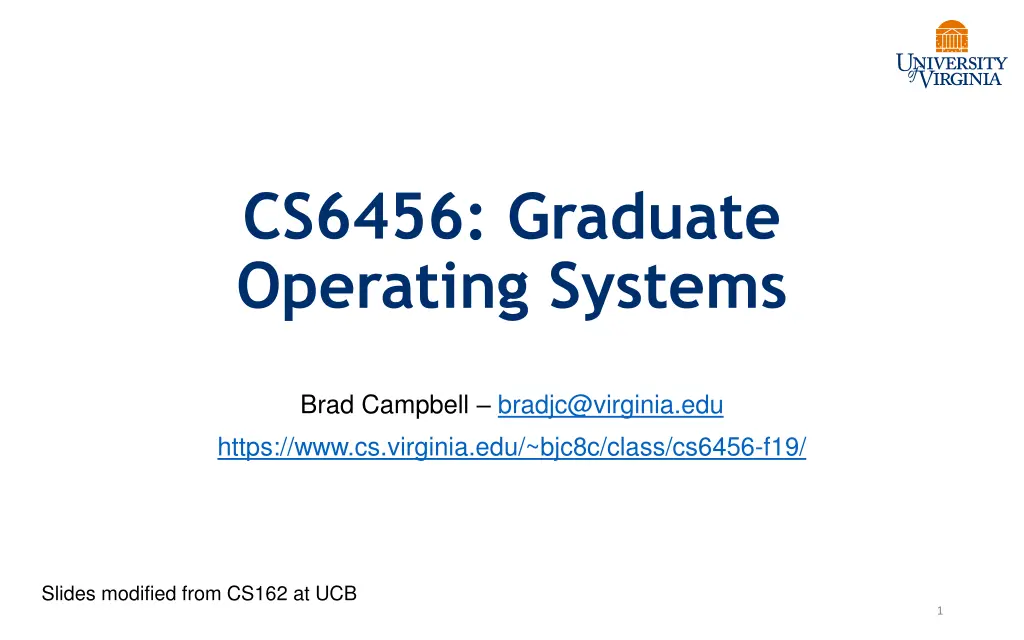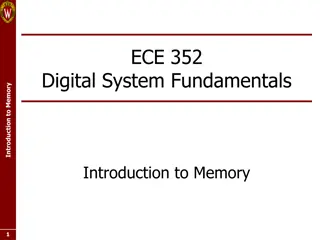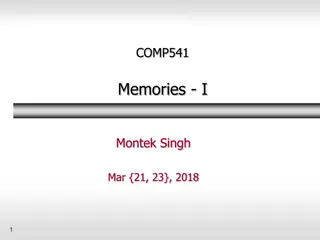
Graduate Operating Systems Overview and Memory Management
Explore the fundamentals of graduate-level operating systems, including memory management concepts such as multiplexing, general address translation, and segmentation. Discover the challenges of internal and external fragmentation in memory allocation, as well as the benefits and limitations of segmentation for managing virtual address spaces.
Download Presentation

Please find below an Image/Link to download the presentation.
The content on the website is provided AS IS for your information and personal use only. It may not be sold, licensed, or shared on other websites without obtaining consent from the author. If you encounter any issues during the download, it is possible that the publisher has removed the file from their server.
You are allowed to download the files provided on this website for personal or commercial use, subject to the condition that they are used lawfully. All files are the property of their respective owners.
The content on the website is provided AS IS for your information and personal use only. It may not be sold, licensed, or shared on other websites without obtaining consent from the author.
E N D
Presentation Transcript
CS6456: Graduate Operating Systems Brad Campbell bradjc@virginia.edu https://www.cs.virginia.edu/~bjc8c/class/cs6456-f19/ Slides modified from CS162 at UCB 1
Memory: Questions to start with What is the fundamental problem? Why is it the OS s job to manage? 2
Memory Multiplexing Goals 1. Protection Private memory of other processes/OS remains private Even from malicious processes 2. Controlled Overlap Want processes and OS to share memory for communication, cooperation Or just to save space (e.g., shared libraries) 3. Uniform View of Memory No need to change binary file's addresses when we want to execute two instances of it No need to change a program to let it use more memory 3
General Address Translation Virtual Addresses Physical Addresses CPU MMU Each process, kernel have a different address space Address Space = All addresses a process can touch Two views of memory: 1. View from the CPU what the program sees (virtual) 2. View from physical memory (physical) 3. MMU is hardware that converts between the two 4
Segmentation 1 1 4 1 2 3 2 2 4 3 physical memory space user view of memory space Manage each region of address space as an independent unit One process uses multiple contiguous allocations of memory, called segments 9
Example: Four Segments (16-bit Addresses) Seg ID # 0 (code) 1 (data) 2 (shared) 3 (stack) 0x0000 Base 0x4000 0x4800 0xF000 0x0000 Limit 0x0800 0x1400 0x1000 0x3000 Seg 15 Virtual Address Format Offset 14 13 0 SegID = 0 0x0000 0x4000 SegID = 1 0x4000 0x4800 0x5C00 0x8000 Space for Other Apps 0xC000 0xF000 Virtual Address Space Physical Address Space
Segmentation Internal fragmentation? We can have large, unused gaps in virtual address space that don t correspond to any allocated segment But segments must be contiguous in physical memory Reserve extra space at beginning? Expansion is difficult External fragmentation? Yes may need to rearrange chunks of memory Segments are smaller than full process memory image, hopefully less work Sharing? Yes! Allow virtual addresses in two processes to map to same segment in physical mem. But can only share at segment granularity One shared library per segment? Will we run out of segments? 0x0000 0x4000 0x4800 0x5C00 0xF000 Virtual Address Space 13
How can we do better? Allocate at finer granularity than segments Allocate memory in fixed-size chunks: pages All allocations are full pages All holes are multiples of a page size Expanding memory footprint: allocate new page No need to relocate existing allocations No struggle to find free region of proper size 15
Whats the catch? More bookkeeping Need to track physical memory location of each page Need to track metadata (valid, permissions) per page Page size represents a tradeoff Larger: Fewer pages to keep track of, more internal fragmentation Smaller: Less wasted space, more pages to track Less locality: Sequential access in virtual space is not necessarily sequential in physical space Jumping across page boundaries 16
Implementing Paging Virtual Page # Virtual Address: Offset PageTablePtr page #0 page #1 page #1 V,R V,R V,R,W V,R,W N V,R,W Physical Frame # Offset V,R Physical Address page #2 page #3 page #4 page #5 > PageTableSize Check Perm Access Error Access Error Page Table: Process-Specific map for bookkeeping Tells us in which physical page frame our virtual page is stored Virtual page number is index into table Table itself resides in physical memory Trigger fault if page access is not permitted 17
Address Translation: Overhead Segmentation: Segment Table One table entry per segment Few segments, so typically small Potentially store in registers Paging: Page Table Allocate physical memory to store table Extra memory access per operation Once to translate address, second to do actual work Tables can get large (1 million entries on 32-bit machine) 19
What about Sharing? Virtual Address (Process A): Virtual Page # Offset PageTablePtrA page #0 page #1 page #2 page #2 V,R V,R V,R,W V,R,W N V,R,W V,R,W page #3 page #4 page #5 Shared Page PageTablePtrB page #0 page #1 page #2 page #3 page #4 page #4 V,R N V,R,W N V,R V,R,W This physical page appears in address space of both processes V,R page #5 Virtual Address (Process B): Virtual Page # Offset 21
Paging: Allocation Page Table Virtual memory view Physical memory view 11111 11101 11110 11100 11101 null 11100 null 11011 null 11010 null 11001 null 11000 null 10111 null 10110 null 10101 null 10100 null 10011 null 10010 10000 10001 01111 10000 01110 01111 null 01110 null 01101 null 01100 null 01011 01101 01010 01100 01001 01011 01000 01010 00111 null 00110 null 00101 null 00100 null 00011 00101 00010 00100 00001 00011 00000 00010 1111 1111 stack stack 1110 0000 1110 0000 1100 0000 What happens if stack grows to 1110 0000? heap 1000 0000 heap 0111 000 data 0101 000 data 0100 0000 code 0001 0000 code 0000 0000 0000 0000 page # offset 22
Summary: Paging Virtual memory view Page Table Physical memory view 11111 11101 11110 11100 11101 10111 11100 10110 11011 null 11010 null 11001 null 11000 null 10111 null 10110 null 10101 null 10100 null 10011 null 10010 10000 10001 01111 10000 01110 01111 null 01110 null 01101 null 01100 null 01011 01101 01010 01100 01001 01011 01000 01010 00111 null 00110 null 00101 null 00100 null 00011 00101 00010 00100 00001 00011 00000 00010 1111 1111 stack stack 1110 0000 1110 0000 1100 0000 stack Allocate new pages where room! heap 1000 0000 heap 0111 000 data 0101 000 data 0100 0000 code 0001 0000 code 0000 0000 0000 0000 page # offset 23
Paging: Hardware Support Special Register to store page table pointer Modified in kernel mode only Change register values on context switch Page Table Lookup Two physical memory accesses per virtual access Later: making this faster Modern systems do all of this in hardware 24
Page Table Issues What if address space is mostly unused? Say we have 4K pages and 2GB of virtual address space 512K page table entries Megabytes of space for table itself How about 64-bit x86 machine? ~256 TB of virt addr space 64 billion page table entries Gigabytes of space for table itself Even though most of this address space is unused by the process in its lifetime Apply tree structure to virtual memory: Multilevel Page Tables 25
Two-Level Page Tables Physical Address: Physical Page # Offset 10 bits Virtual P1 index 10 bits Virtual P2 index 12 bits Virtual Address: Offset 4KB PageTablePtr 4 bytes A tree of page tables Each "node" has a fixed size x86: 1024 4-byte entries Still just one register to change on context switch 4 bytes 26
Two-Level Page Tables Physical Address: Physical Page # Offset 10 bits Virtual P1 index 10 bits Virtual P2 index 12 bits Virtual Address: Offset 4KB PageTablePtr 4 bytes Big gaps in virtual address space don't need second level page tables 4 bytes 27
Two-Level Page Tables Physical Address: Physical Page # Offset 10 bits Virtual P1 index 10 bits Virtual P2 index 12 bits Virtual Address: Offset 4KB PageTablePtr 4 bytes But we're also making two memory accesses just for translation 4 bytes 28
Two-Level Paging Example Virtual memory view Page Table (level 1) Page Tables (level 2) Physical memory view 1111 1111 stack 11 11101 10 11100 01 10111 00 10110 stack 1110 0000 1111 0000 1100 0000 stack 11 null 10 10000 01 01111 00 01110 111 110 null 101 null 100 011 null 010 001 null 000 heap 1000 0000 heap 0111 000 11 01101 10 01100 01 01011 00 01010 data 0101 000 data 0100 0000 11 00101 10 00100 01 00011 00 00010 code page2 # 0001 0000 code 0000 0000 0000 0000 29 page1 # offset
Page Table Discussion Good Points: Easy memory allocation (fixed size chunks) Easy sharing among processes No physical memory used for holes in virtual address sp. Bad Points: Overhead: At least 1 pointer per 4K page Page tables need to be contiguous (tricky allocation) Clever design (x86) can limit them to one page Several memory accesses per translation Later: making this faster 31
Page Tables for Huge Address Spaces Want full 64 bits of address space? How many levels of indirection needed? 10 bits 2 bits 10 bits 10 bits 12 bits 10 bits 10 bits Virtual P2 Index Virtual P3 Index Virtual P4 Index Virtual P6 Index Virtual P5 Index Offset Overhead: Extra space for tables in phys. mem. And additional memory accesses per translation 64-bit x86 does not do this Virtual Addresses are 48 bits long 4-level page table 32
Alternative: Inverted Page Table Until Now: Size of page table proportional to size of virtual address space New Structure: Size of page table proportional to size of physical address space Good if most of address space not in use Particularly 64-bit address space Bad: Complexity How do we deal with hash collisions? Virtual Page # Offset Physical Page # Offset Hash Table 33
Address Translation Comparison Advantages Disadvantages Simple Segmentation Fast context switching: Segment mapping maintained by CPU External fragmentation Paging (single-level page) No external fragmentation, fast easy allocation Large table size ~ virtual memory Internal fragmentation Paged segmentation Table size ~ # of pages in virtual memory, fast easy allocation Multiple memory references per page access Two-level pages Inverted Table Table size ~ # of pages in physical memory Hash function more complex No cache locality of page table 37
Real World: 32-bit x86 Has both segmentation and paging Segmentation different from what we've described Segment identified by instruction, not address Note: x86 actually offers multiple modes of memory operation, we'll talk about common one 39
Real Example: Intel x86 (Old Days) 80386 Special Registers Today: Register points to segment table in physical memory 40
Intel x86 Six segments: cs (code), ds (data), ss (stack), es, fs, gs (extras) Instructions identify segment to use mov [es:bx], ax Some instructions have default segments, e.g. push and pop always refer to ss (stack) Underused in modern operating systems In 64-bit x86, only fs and gs support enforcement of base and bound 41
Okbut its all about the details Remainder of today: Making paged virtual memory usable Enabling protection Increasing performance 43
Real Page Table Entries So far, we've said they contain a physical frame # Or the frame # of a page table lower on the "tree" But we want some extra information Present/valid bit: indicate unallocated regions of physical address space Protection bits, e.g. to set certain regions of memory to read-only for sharing 44
32-bit x86 Page Table Entry 10/10/12 Split of Virtual Address Top-level page tables called directories Page Frame Number (Physical Page Number) Free (OS) 11-9 PCD 4 PWT 3 0 L D A U W P 31-12 8 7 6 5 2 1 0 PFN: Physical Page number of page or next page table P: Present Bit (Is page mapping valid?) W: Is this page writable? U: Can we access this page while in user mode? A: Set by hardware when page is first accessed D: Page marked dirty if it is ever modified PWT: Write-through cache behavior PCD: Disable caching for this page 45
Paging Tricks What does it mean if a page table entry doesn't have the valid (present) bit set? Region of address space is invalid or Page is not loaded and ready yet When program accesses an invalid PTE, OS gets an exception (a page fault or protection fault) Options Terminate program (access was actually invalid) Get page ready and restart instruction 46
Example Paging Tricks 1. Demand Paging: Swapping for pages Keep only active pages in memory Not common on modern systems, except perhaps when first loading program Response: Load in page from disk, retry operation 2. Copy on Write (remember fork?) Temporarily mark pages as read-only Allocate new pages when OS receives protection fault 3. Zero-Fill on Demand Slow to overwrite new pages with all zeros Page starts as invalid, zero it out when it's actually used 47
Recall: Dual-Mode Operation Process cannot modify its own page tables Otherwise, it could access all physical memory Even access or modify kernel Hardware distinguishes between user mode and kernel mode with special CPU register Protects Page Table Pointer Kernel has to ensure contents of page tables themselves are not pointed to by any mapping Remember: Page table can mark some frames as off limits for user-mode processes 51
Synchronous Exceptions System calls are on example of a synchronous exception (a "trap" into the kernel) Other exceptions: page fault, access fault, bus error rerun the triggering instruction After fixing something Relies on precise exceptions Faulting Faulting Inst. Inst. User Load Page OS 52
Precise Exceptions Definition: Machine's state is as if the program executed up to the offending instruction Hardware has to complete previous instructions Remember pipelining May need to revert side effects if instruction was partially executed OS relies on hardware to enforce this property 53
Caching Cache: Repository for copies that can be accessed more quickly than the originals Goal: Improve performance We'll see lots of applications! Memory Address translations File contents, file name to number mappings DNS records (name to IP addr mappings) 55
Why Bother with Caching? Growing latency gap between CPU and Memory Proc 60%/yr. (2X/1.5yr) 1000 CPU Moore s Law Performance Processor-Memory Performance Gap: (grows 50% / year) 100 10 Less s Law? DRAM 9%/yr. (2X/10 yrs) DRAM 1 1985 1986 1998 1999 1980 1981 1982 1983 1984 1987 1988 1989 1990 1991 1992 1993 1994 1995 1996 1997 2000 Time 56
Why Does Caching Help? Locality! Probability of reference 0 2n - 1 Address Space Temporal Locality (Locality in Time): Keep recently accessed data items closer to processor Spatial Locality (Locality in Space): Move contiguous blocks to the upper levels Main Memory Cache To Processor Blk X From Processor Blk Y 59
Memory Hierarchy Take advantage of the principle of locality to: Present as much memory as in the cheapest technology Provide access at speed offered by the fastest technology Processor Control Tertiary Storage (Disk) Secondary Storage (SSD) Second Level Cache (SRAM) Main Memory (DRAM) Cache On-Chip Registers Datapath 10,000s (10s us) Gs-Ts Speed (ns): 1s 10s-100s 100s 10,000,00s (10s ms) Gs-Ts Size (bytes): 100s Ks-Ms Ms-Gs 60
Types of Cache Miss 1. Compulsory ("cold start"): First access to a block Insignificant in any long-lived process 2. Capacity: Not enough space in cache 3. Conflict: Memory locations map to same cache location 4. Coherence (invalidation): Memory updated externally e.g. multi-core system, or on I/O 61
Where Can a Block Go? Example: Block 12 placed in 8 block cache 32-Block Address Space: Block no. 1 1 1 1 1 1 1 1 1 1 2 2 2 2 2 2 2 2 2 2 3 3 0 1 2 3 4 5 6 7 8 9 0 1 2 3 4 5 6 7 8 9 0 1 2 3 4 5 6 7 8 9 0 1 Direct mapped: block 12 can go only into block 4 (12 mod 8) Set associative: block 12 can go anywhere in set 0 (12 mod 4) Fully associative: block 12 can go anywhere Block no. 0 1 2 3 4 5 6 7 0 1 2 3 4 5 6 7 0 1 2 3 4 5 6 7 Block no. Block no. Set 0 Set 1 Set 2 Set 3 70
Which block should be replaced on a miss? Easy for Direct Mapped: Only one possibility Set Associative or Fully Associative: Random LRU (Least Recently Used) Miss rates for a workload: 2-way 4-way 8-way Size LRU Random LRU Random 16 KB 5.2% 5.7% 4.7% 64 KB 1.9% 2.0% 1.5% 256 KB 1.15% 1.17% 1.13% 1.13% 1.12% 1.12% LRU Random 4.4% 1.4% 5.3% 1.7% 5.0% 1.5% 71
What Happens When We Write to a Cached Address? Write Through: Update both cache block and corresponding location in main memory Simple to implement, but now we wait for writes? Write Back: Update only the cached copy at time of write. Update main memory when cache block is removed later on. Repeated writes not all sent to RAM A read may trigger a write (evicting a cache block) More complex (need modified "dirty" bit) 72
Caching Applied to Address Translation TLB Virtual Address Physical Address Cached? CPU Physical Memory Yes No Translate (MMU) Data Read or Write (untranslated) 74
Caching Address Translations Locality in page accesses? Yes: Spatial locality, just like CPU cache TLB: Cache of page table entries 75
TLB and Context Switches Do nothing upon context switch? New process could use old process's address space! Option 1: Invalidate ("flush") entire TLB Simple, but very poor performance Option 2: TLB entries store a process ID Called tagged TLB Requires additional hardware 76
TLB and Page Table Changes Think about what happens we we use fork OS marks all pages in address space as read-only After parent returns from fork, it tries to write to its stack Triggers a protection fault. OS makes a copy of the stack page, updates page table. Restarts instruction. 77
TLB and Page Table Changes What if TLB had cached the old read/write page table entry for the stack page? OS marks all pages in address space as read-only After parent returns from fork, it tries to write to its stack Triggers a protection fault. OS makes a copy of the stack page, updates page table. Restarts instruction. 78
How do we invalidate TLB entries? Hardware could keep track of where page table for each entry is and monitor that memory for updates Very complicated! Especially for multi-level page tables and tagged TLBs Instead: The OS must invalidate TLB entries So TLB is not entirely transparent to OS 79






















